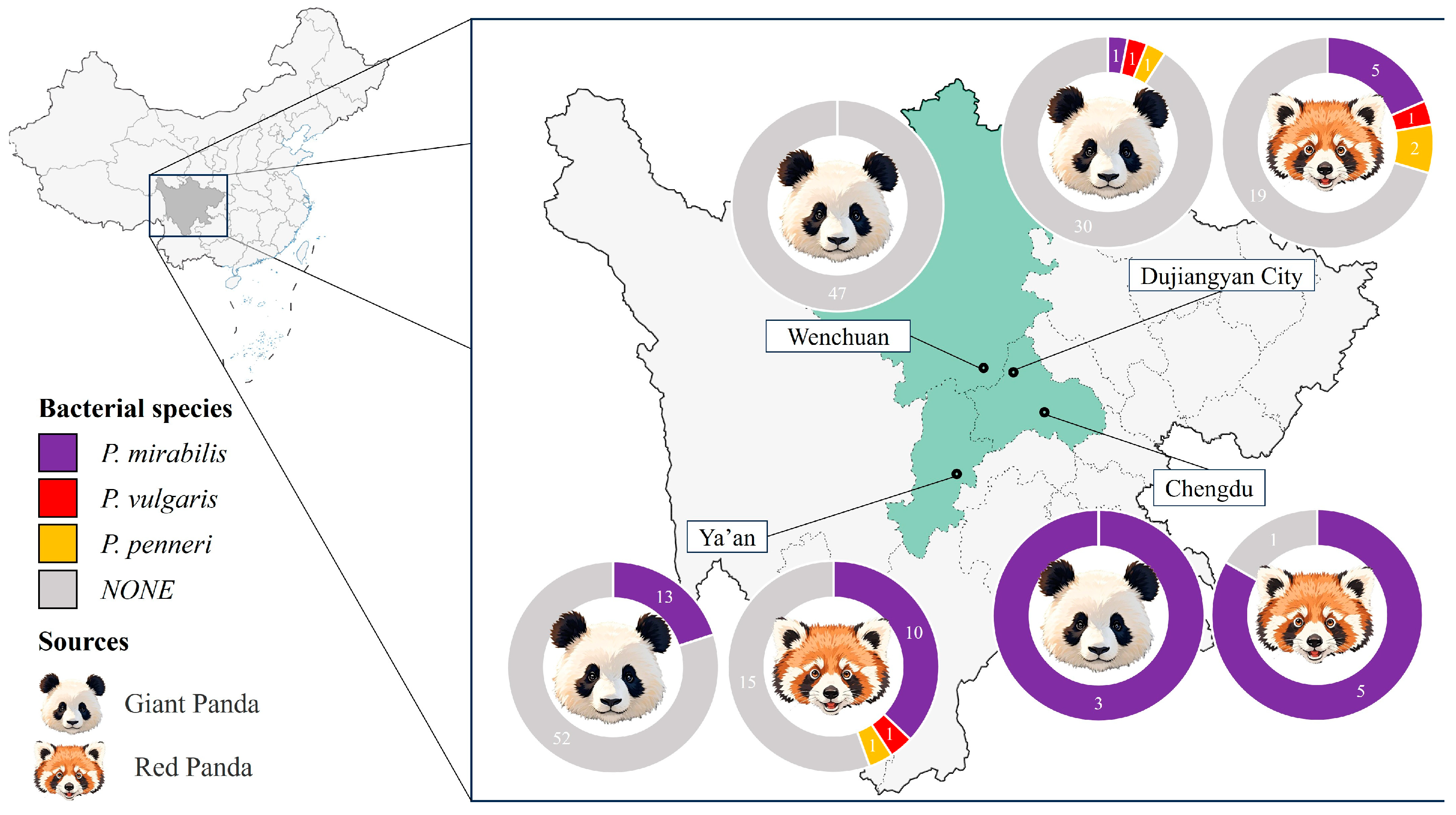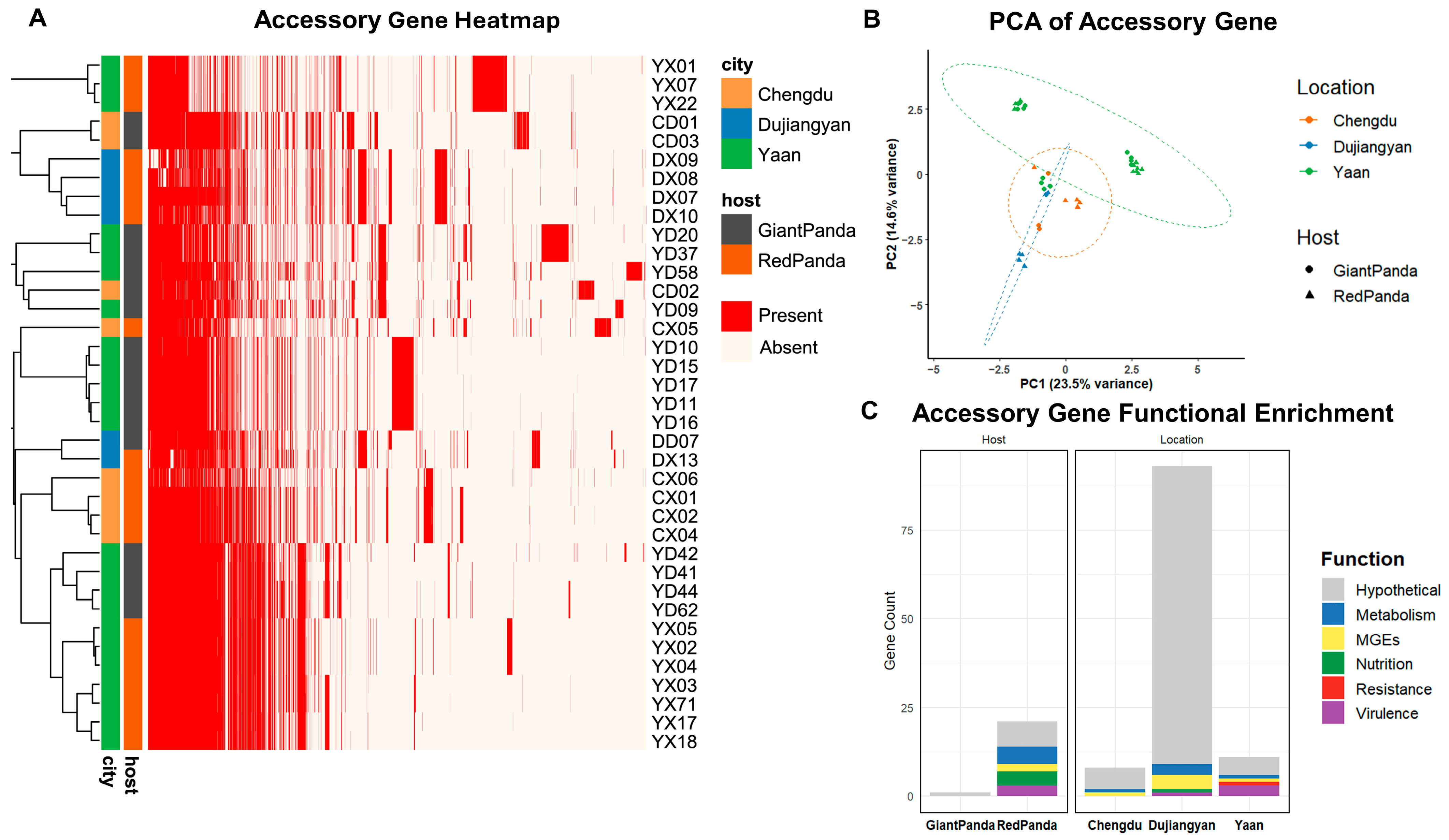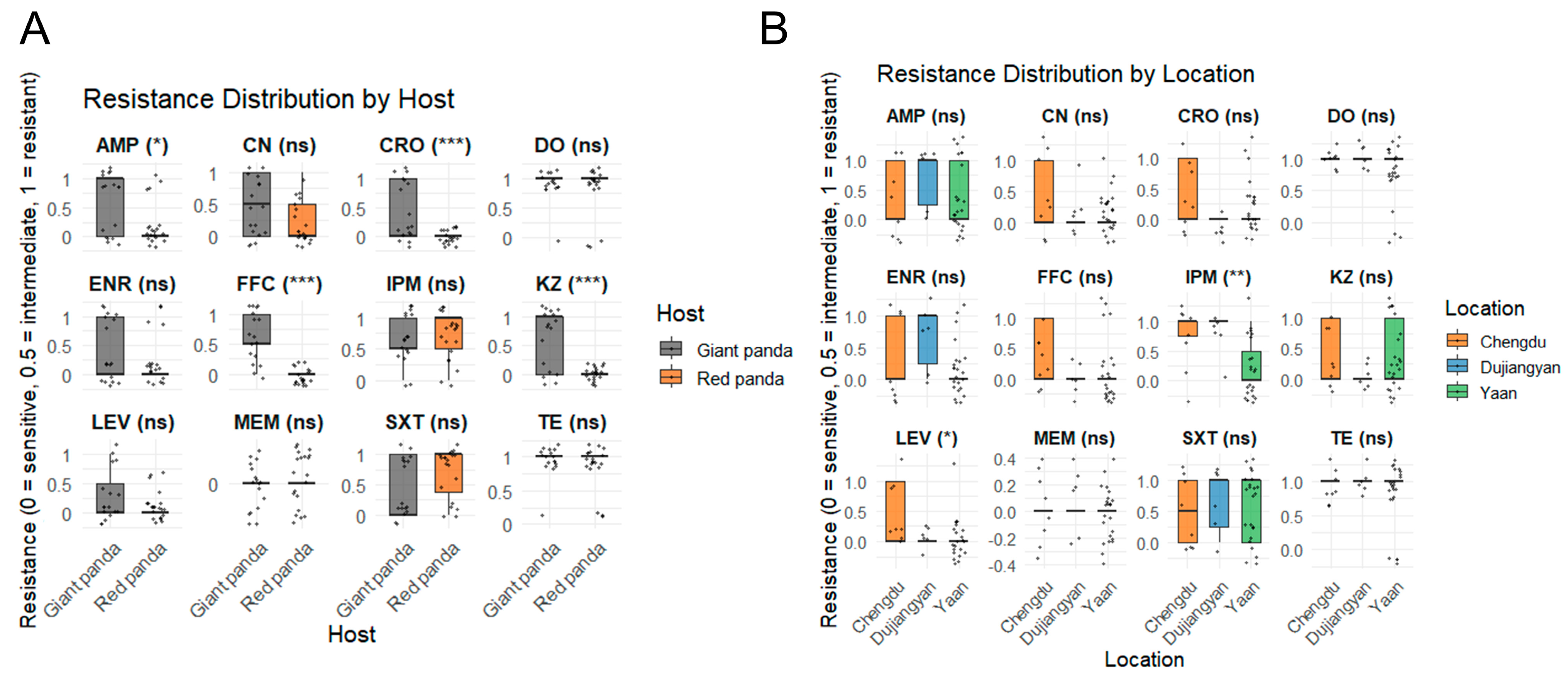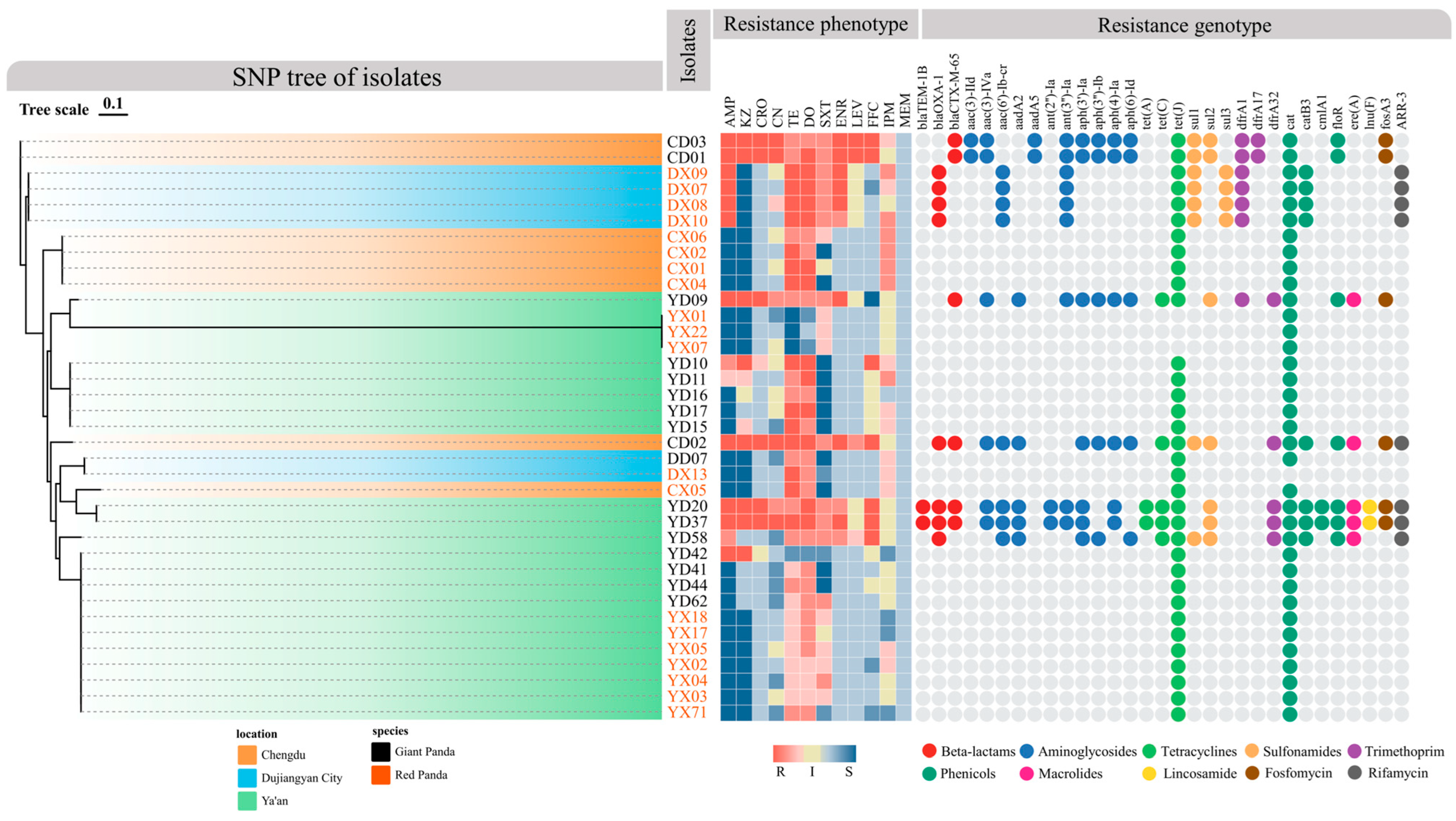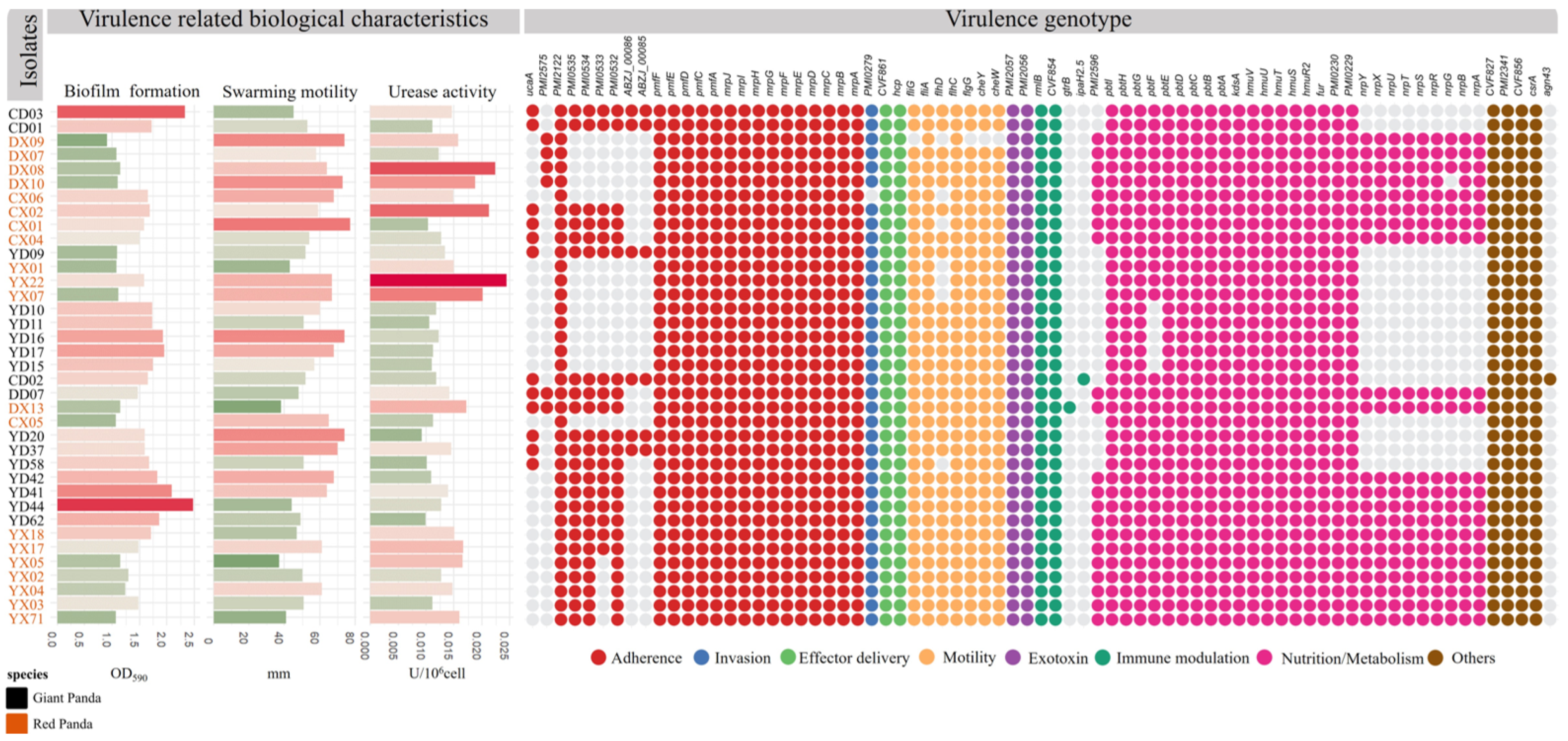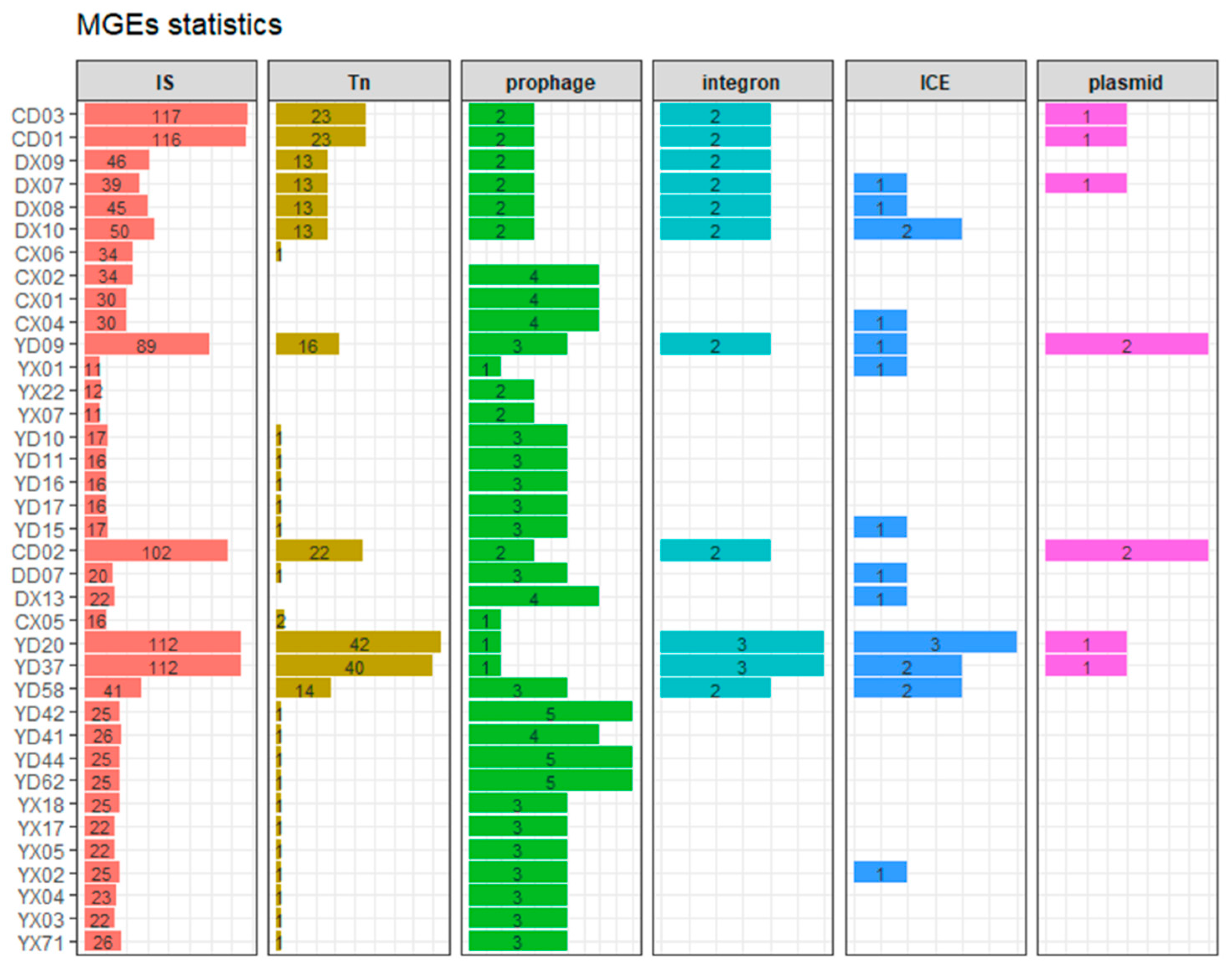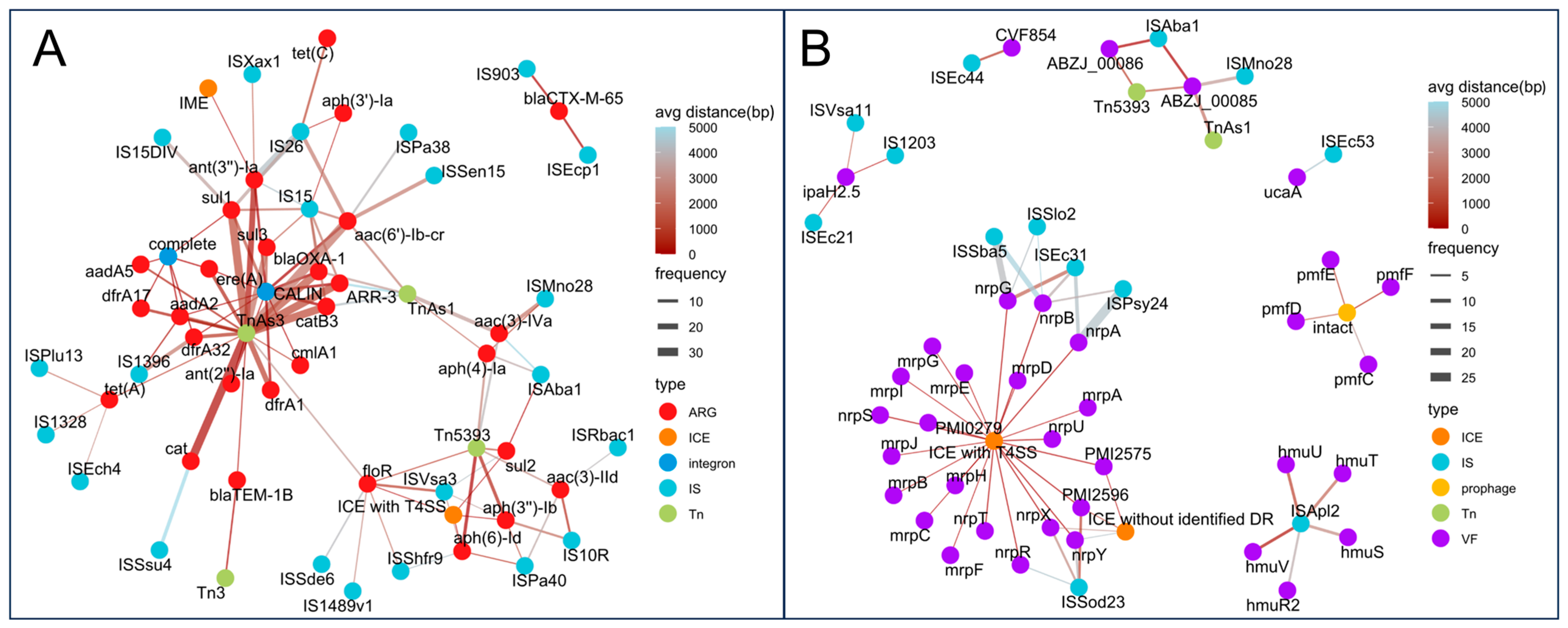1. Introduction
Proteus mirabilis is a commensal bacterium commonly found in the gastrointestinal tracts of humans and animals, yet it is also recognized as an opportunistic pathogen capable of causing a broad spectrum of infections [
1].
P. mirabilis-associated diseases, including acute diarrhea, reproductive tract infections, and wound infections, have been documented in both giant pandas and red pandas [
2]. This pathogen carries multiple virulence factors that enhance colonization and pathogenic potential: fimbriae mediate epithelial adhesion; urease contributes to the formation of struvite and calcium phosphate urinary stones; flagella facilitate motility; and cytotoxicity is enhanced by both hemolysin and the secreted protease ZapA [
3]. Furthermore,
P. mirabilis exhibits unique swimming and swarming motility, enabling rapid dissemination within the host [
4]. It is also capable of forming crystalline biofilms, substantially increasing its resistance to antimicrobial agents [
5]. In recent years, antimicrobial resistance (AMR) in
P. mirabilis has become an escalating concern [
6]. Under antimicrobial selective pressure,
P. mirabilis continuously acquires additional antimicrobial resistance genes (ARGs) via horizontal gene transfer (HGT), contributing to the emergence of multidrug-resistant (MDR) strains. In recent years, extensively drug-resistant (XDR) and even pandrug-resistant (PDR)
P. mirabilis isolates have been reported, and strains producing ESBLs and carbapenemases have been widely detected in animals [
7]. Combined with its intrinsic resistance to polymyxins, nitrofurantoin, tigecycline, and tetracyclines, treatment options for
P. mirabilis infections have become increasingly limited [
8].
The giant panda (
Ailuropoda melanoleuca) and red panda (
Ailurus fulgens), two endangered mammalian species endemic to the Himalaya–Hengduan Mountains region, hold significant research value in evolutionary biology and conservation medicine [
4,
9]. Although they belong to distinct families within the order Carnivora (
Ursidae vs.
Ailuridae), both species exhibit highly specialized bamboo-feeding adaptations and overlapping ecological niches as a result of convergent evolution [
10]. This ecological convergence has led to widespread zoo management practices that house both species in shared enclosures, based on habitat similarity. Given that numerous zoos and conservation organizations conduct rescue and reintroduction programs for giant pandas and red pandas, the introduction of highly resistant
P. mirabilis strains into the wild could pose a serious threat to other wildlife [
11]. Additionally, red pandas are often housed in open enclosures, and public interactions for educational purposes may create pathways for direct or indirect transmission of resistant
P. mirabilis between humans and pandas [
12]. Therefore, elucidating the antimicrobial resistance mechanisms and transmission pathways of
P. mirabilis is a critical step toward mitigating these emerging threats. However, such studies remain scarce, and existing data are insufficient to inform effective control strategies.
In this study, P. mirabilis strains were isolated from the feces of both giant and red pandas in various zoos and conservation centers across Sichuan Province. We assessed their antimicrobial resistance profiles and virulence-associated phenotypes. Moreover, through whole-genome sequencing, we conducted a comprehensive genomic analysis to uncover the genetic diversity, antimicrobial resistance genes, and virulence determinants among P. mirabilis isolates from different geographic locations and host species (giant pandas and red pandas). This study aims to characterize the antimicrobial resistance and pathogenic potential of P. mirabilis in the gut microbiota of captive giant and red pandas, thereby providing a scientific basis for future surveillance, targeted control strategies, and conservation practices.
3. Results
3.1. Isolation of Proteus mirabilis from Captive Giant and Red Pandas in Sichuan Province
A total of 208 fecal samples were collected from captive giant pandas (
Ailuropoda melanoleuca,
n = 148) and red pandas (
Ailurus fulgens, n = 60) housed in zoos and conservation centers across Sichuan Province, with one sample collected per animal. As shown in
Figure 1, a total of 37
Proteus mirabilis isolates were obtained through streaking on LB and SS agar plates, including 17 from giant pandas (11.5%) and 20 from red pandas (33.3%). The isolation rate was higher in red pandas than in giant pandas.
Regional isolation rates varied, with the highest observed in Chengdu (88.9%, 8/9), followed by Ya’an (25.0%, 23/92) and Dujiangyan (10.0%, 6/60); no
P. mirabilis isolates were recovered from Wenchuan (0/47). In addition to
P. mirabilis, three
Proteus vulgaris and four
Proteus penneri isolates were also obtained
Figure 1.
3.2. Genomic Composition and Characteristics of P. mirabilis Isolates from Giant and Red Pandas
Core and pan-genome curves were generated based on gene presence-absence data from 37
P. mirabilis strains, as shown in
Figure S1. As the number of genomes increased, the size of the core genome steadily decreased and plateaued at 2476 genes, indicating a conserved genetic backbone. In contrast, the pan genome continued to increase, reaching over 5997 genes, suggesting an open and highly variable accessory gene pool across strains.
Principal component analysis (PCA) based on accessory gene presence/absence (
Figure 2B) demonstrated distinct spatial separation among isolates. Giant pandas isolates clustered more tightly, and geographic origin had a greater impact on accessory genome diversity than host species.
3.3. Gene Enrichment Analysis
As shown in
Figure 2C, enrichment analysis based on gene presence/absence was conducted to explore host- and location-specific features of the accessory genome.
P. mirabilis strains derived from red pandas exhibited 21 significantly enriched accessory genes, primarily associated with virulence, nutrient acquisition, metabolism, and mobile genetic elements (MGEs), suggesting higher genomic plasticity and adaptive potential. In contrast, only one hypothetical gene was enriched in strains from giant pandas.
A total of 112 location-specific genes were identified, revealing distinct geographic patterns. Dujiangyan isolates harbored the largest number (n = 93), with genes enriched in MGEs and metabolic pathways. Ya’an isolates carried 11 enriched genes, including three virulence factors (rfaB, mxiH, hcpA_3), one resistance gene (pbpE), one metabolic gene (smc), one MGE (group_1355), and five hypothetical proteins. Chengdu isolates exhibited the fewest enriched genes (n = 8), consisting mostly of hypothetical proteins (n = 7) and one MGE (group_344). These findings indicate that both host species and geographic origin contribute to shaping the accessory genome composition of P. mirabilis, with geographic factors playing a more prominent role.
3.4. SNP Analysis
SNP-based phylogenetic analysis revealed distinct clustering patterns shaped by both geographic origin and host species (Figure 4). Strains from Dujiangyan and Chengdu clustered closely in the upper portion of the tree, suggesting shared ancestry or similar transmission dynamics. In contrast, isolates from Ya’an formed a separate cluster, potentially reflecting higher genetic homogeneity or localized selective pressures. Within each geographic group, strains from the same host species tended to cluster together, indicating host-associated constraints on genetic divergence. Collectively, these results highlight the combined influence of geography and host species in shaping the phylogenetic structure of P. mirabilis.
3.5. Antimicrobial Resistance Profiles of Proteus mirabilis Isolates
Figure 3A summarizes the minimum inhibitory concentration (MIC) profiles of 37
P. mirabilis isolates obtained from giant pandas and red pandas, revealing notable differences in antimicrobial resistance patterns between host species. Among the 17 isolates from giant pandas, the highest resistance rates were observed for tetracycline and doxycycline (94.1%, 16/17), followed by ampicillin and cefazolin (58.8%, 10/17). Moderate resistance levels were detected for sulfamethoxazole–trimethoprim and enrofloxacin (41.2%), florfenicol (47.1%), gentamicin and ceftriaxone (35.3%), and imipenem (29.4%). All isolates were fully susceptible to meropenem. In contrast, among the 20 isolates from red pandas, the highest resistance was likewise observed for tetracycline and doxycycline (85.0%, 17/20), followed by sulfamethoxazole–trimethoprim (65.0%) and imipenem (55.0%). Resistance to enrofloxacin (15.0%) and ampicillin (20.0%) was comparatively low, and all isolates were fully susceptible to cefazolin, ceftriaxone, levofloxacin, florfenicol, and meropenem.
Regionally in
Figure 3B, isolates from Chengdu and Dujiangyan exhibited significantly higher resistance to imipenem compared to those from Ya’an (
p < 0.01). Additionally, strains from Chengdu showed greater resistance to levofloxacin relative to isolates from both Dujiangyan and Ya’an (
p < 0.05).
3.6. Distribution and Diversity of Antimicrobial Resistance Genes in Isolated Strains of Proteus mirabilis
As shown in
Figure 4, using the CARD database via Abricate, 31 ARGs belonging to 10 classes—including β-lactams, aminoglycosides, tetracyclines, sulfonamides, trimethoprim, chloramphenicols, macrolides, lincosamides, fosfomycin, and rifamycins—were identified among the 37
P. mirabilis isolates. Overall, isolates from giant pandas harbored more ARGs than those from red pandas. Notably, several strains (e.g., YD20, YD37) carried genes spanning nearly all resistance classes, suggesting a high potential for extensive drug resistance (XDR). Of particular concern, the ESBL gene
blaCTX-M-65 was exclusively detected in giant panda isolates, suggesting a potential clinical risk. In terms of drug resistance mechanism, aminoglycoside genes were the most prevalent (e.g.,
aac(3)-IId,
aadA5,
aph(3′)-Ia,
aph(6)-Id), followed by β-lactamases
blaTEM-1B,
blaOXA-1, tetracycline resistance genes (
tet(A),
tet(C),
tet(J)) and sulfonamide resistance genes (
sul1,
sul2,
sul3).
Regional and host-specific analysis revealed significant variation in ARG distribution. In Chengdu, giant panda isolates had a high ARG load, while red panda isolates carried few. The pattern was reversed in Dujiangyan, where red panda isolates harbored a broader range of ARGs. In Ya’an, strains showed greater variability: some giant panda isolates (e.g., YD20 and YD37) exhibited the highest ARG diversity across all classes, whereas red panda isolates carried very few.
Rare ARGs such as lnu(F), ere(A), ARR-3, and fosA3 were detected sporadically, suggesting limited spread. Collectively, P. mirabilis strains exhibited diverse resistance profiles, with giant panda isolates showing greater ARG burden and potential multidrug resistance. ARG distribution was shaped by both host and geographic factors, highlighting the need for targeted regional surveillance.
3.7. Correlation Analysis Between ARGs and Drug Resistance Phenotypes
The resistance gene profiles generally aligned with the observed phenotypic resistance patterns (
Figure 4). Among β-lactam-resistant strains, 78.6% carried corresponding resistance genes, and all ceftriaxone-resistant isolates carried the
blaCTX-M-65 gene. Similarly, resistance to gentamicin, sulfonamides, and trimethoprim consistently correlated with the presence of their respective ARGs. Strains carrying
aac(6′)-Ib-cr exhibited resistance or intermediate susceptibility to enrofloxacin and levofloxacin.
Although nearly all isolates carried the cat gene, florfenicol resistance was observed only in those harboring additional chloramphenicol resistance genes (catB3, cmlA1, floR). In addition, previous studies have shown that P. mirabilis exhibits intrinsically elevated MIC values to imipenem; thus, many strains displayed resistance or intermediate susceptibility without harboring known carbapenemase genes.
3.8. Virulence-Associated Traits of Proteus mirabilis Isolated Strains
As shown in
Figure S2,
P. mirabilis strains isolated from giant pandas generally exhibited stronger biofilm-forming abilities than those from red pandas. Based on the ODc, the biofilm-forming ability of isolates can be divided into the following four types: non-biofilm formers (OD ≤ ODc), weak (ODc < OD
590 ≤ 2ODc), moderate (2ODc < OD
590 ≤ 4ODc), strong (4ODc < OD
590 ≤ 8ODc), and very strong (OD
590 > 8ODc). Quantitative analysis revealed significantly higher biofilm biomass among giant panda-derived strains (OD
595: 1.03–2.77) compared to red panda-derived strains (OD
595: 0.865–1.78), with this difference being statistically significant (t = 8.45, df = 89.34,
p = 4.94 × 10
−13). Regarding swarming motility, all giant panda isolates and most red panda isolates displayed strong motility, while three red panda strains (YX05, YX71, DX13) exhibited only moderate motility.
Significant differences in urease activity were also observed between the two host groups. Urease activity among giant panda-derived strains ranged from 0.0093 to 0.0146 U/10
6 cells (mean = 0.0120, SD = 0.00241), while red panda strains showed a broader range (0.0103–0.0244 U/10
6 cells) and a higher average activity (mean = 0.0159, SD = 0.00485). This difference was statistically significant (t = –5.62, df = 85.06,
p = 2.41 × 10
−7), suggesting host-associated differences in urease expression (
Figure S3). All 37 isolates exhibited α-hemolysis, as indicated by uniform translucency on 5% sheep blood agar plates, likely resulting from their strong swarming motility (
Figure S4).
3.9. VAGs Analysis of Isolated Strains
As shown in
Figure 5, a total of 73 VAGs were identified across the 37
P. mirabilis isolates, encompassing functions related to motility, chemotaxis, toxin production, adhesion, and immune evasion. Most isolates carried more than 60 VAGs, with 44 genes conserved across all strains, forming a core virulence repertoire shared by both giant panda- and red panda-derived isolates. Variation at the strain level was observed. The red panda-derived strain DX13 harbored the highest number of VAGs (n = 69), although on average, isolates from giant pandas carried slightly more virulence genes than those from red pandas. Some genes—such as
agn43,
ipaH2.5, and
gtrB—were found in only a few isolates, suggesting potential acquisition via horizontal gene transfer or niche-specific adaptation.
Among the 24 adhesion-related genes, 16 were universally present. Notably, seven genes encoding uroepithelial cell adhesins (UCA) were detected in 54.8% of strains, with DD07 and DX13 harboring all seven. Capsule-associated genes (ABZJ_00085 and ABZJ_00086) were exclusively found in giant panda-derived strains. All isolates carried key biofilm-associated genes (PmfACDEF, MR/P fimbriae) and hemolysin genes (hpmA, hpmB). Only one invasion gene, ZapA, was identified. Flagellar genes were largely conserved across strains, although DX09 possessed only two, and a few isolates lacked flhD, a transcriptional activator of flagellar biosynthesis. Immune-related genes (rmlB, CVF854) were universally present, whereas gtrB and ipaH2.5 were rare. Genes involved in nutrient acquisition, such as the siderophore systems pbtABCDEFGHI, hmuR2STUV, and fur, were widely distributed. Non-ribosomal peptide synthetase (NRPS) gene clusters for iron uptake were complete in 20 isolates, while others lacked them entirely. Finally, all strains harbored csrA, a key global regulator involved in motility and biofilm formation.
3.10. Correlation Analysis Between VAGs and Phenotypic Traits
As shown in
Figure 6, no strong correlations were observed between VAGs and phenotypic traits. However, weak positive correlations were identified between
PMI0533 and biofilm formation (r = 0.38,
p < 0.05), as well as between
pbtF or
PMI2575 and urease activity (r = 0.33 and 0.35, respectively;
p < 0.05). Meanwhile,
PMI0532,
PMI0534, and
PMI0535 showed moderate negative correlations with swarming motility (r = −0.40,
p < 0.05), and
pbtF and
PMI2575 were also negatively associated with biofilm formation (r = −0.44 and −0.47, respectively;
p < 0.01).
3.11. Correlation Between Mobile Genetic Elements (MGEs) and ARGs/VAGs
In this study, a total of 1855 mobile genetic elements (MGEs) were identified, including 1437 insertion sequences (IS), 252 transposons (Tn), 24 integrons, 9 plasmids, 102 prophages, and 31 integrative and conjugative elements (ICEs), as shown in
Figure 7. Strains from CD01-03, YD20, and YD37 carried more than 100 IS elements and over 20 Tn elements, showing higher levels of antimicrobial resistance. This trend was particularly evident for integrons and plasmids, as all strains carrying integrons and plasmids were MDR.
Spearman correlation analysis revealed that insertion sequences (IS), transposons (Tn), integrons, and plasmids were positively associated with resistance to all Antimicrobials except imipenem. ICEs correlated positively with enoxacin and levofloxacin resistance, while prophages showed negative correlations with resistance to five Antimicrobials, suggesting they may suppress resistance (
Figure 8A).
The correlation between MGEs and resistance genes was also strong (
Figure 8B). Except for the cat gene, all 30 resistance genes were positively correlated with IS and Tn to varying degrees (r = 0.33–0.74,
p < 0.05–0.001). Integrons were positively correlated with 29 resistance genes, with the strongest correlation observed for ant(3″)-Ia (r = 0.88,
p < 0.001). ICEs exhibited negative correlations with
aac(3)-IId,
aadA5,
CAT, and
dfrA1, while showing positive correlations with other resistance genes. Plasmids were positively correlated with nearly all resistance genes except
cat,
sul3, and
tet(J). Interestingly, ICEs and plasmids showed opposing patterns, hinting at gene-specific MGE preferences. Prophage-gene correlations echoed resistance profiles.
Correlation between MGEs and virulence genes is shown in
Figure 8C. IS elements were significantly positively correlated with adhesion and iron acquisition genes (
p < 0.05). Plasmids significantly positively correlated with
ABZJ_
00085 and
ABZJ_
00086 (
p < 0.001), but negatively with nutrient acquisition genes, indicating that plasmids might negatively impact bacterial fitness. Prophages were positively correlated with adhesion and nutrient genes (
p < 0.05) but negatively associated with
ABZJ_
00085/
00086, highlighting their complex role in virulence
(p < 0.05).
3.12. Co-Localization of Mobile Genetic Elements (MGEs) with ARGs and VAGs
To further assess the link between MGEs and ARGs/VAGs, genes located within 5000 bp of an MGE or fully contained within it were considered co-localized. As shown in
Figure 9A, several IS elements, such as
IS903 and
ISEcp1, consistently co-localized with
blaCTX-M-65, while
IS15,
IS26, and
ISAba1 were associated with multiple ARGs, suggesting these resistance genes may form resistance islands and have the potential for horizontal transfer.
Tn5393 showed frequent co-localization with various aminoglycoside and sulfonamide resistance genes. CALINS and complete integrons carried a broad spectrum of ARGs across nearly all Antimicrobial classes. Moreover, ICEs with type IV secretion systems (T4SS) also carried resistance genes such as
aph(3″)-Ib,
aph(6)-Id,
floR, and
sul2. Additionally, we identified an Integrative and Mobilizable Element (IME) carrying
ant(3″)-Ia. In terms of VAGs, extensive co-localization was also observed (
Figure 9B). Some IS elements were co-localized with specific VAGs, such as
IS1203 with
ipaH2.5. More commonly, an IS element was co-localized with multiple VAGs, such as
ISApl2 with
hmuSTUVR2;
ISSod23 with
PMI2596 and
nrpRXY; and
ISEc31 with
nrpABG. For Tn elements,
Tn5393 was co-localized with
ABZJ_00085 and
ABZJ_00086, and
TnAs1 was co-localized with
ABZJ_00085. Furthermore, ICEs with T4SS carried numerous VAGs, including
nrpABGRSTUXY,
mrpABCDEFGHIJ,
PMI2575,
PMI2596, and
PMI0279. Notably, some prophages were co-localized with VAGs, such as
pmfC,
pmfD,
pmfE, and
pmfF. These findings support the idea that ISs, Tns, ICEs, and integrons facilitate the horizontal transfer of both resistance and virulence genes, while prophages mainly contribute to virulence gene mobility.
3.13. Plasmids and ICEs Carrying ARGs and VAGs in P. mirabilis Isolates
Plasmids and integrative and conjugative elements (ICEs) are key mobile genetic elements (MGEs) that enable the horizontal transfer of ARGs and VAGs. In this study, 9 plasmids and 18 ICEs (including ICEs lacking T4SS, i.e., IMEs) were identified in 16 P. mirabilis strains. Except for DD07 and YX02, all MGE-positive strains were multidrug-resistant (MDR).
As shown in
Figure 10A, 3 plasmids carried complete integrons containing intI, and another 3 harbored CALINs; 7 plasmids contained ARGs, with 5 carrying over 10 genes. The plasmid pCD021 encoded 17 ARGs across various antimicrobial classes, including β-lactams (ESBLs), aminoglycosides, tetracyclines, and others. Notably,
blaCTX-M-65 appeared on 5 plasmids, and multiple ARGs were embedded within integrons, posing a high HGT risk. These ARG-rich plasmids were mostly from Chengdu and Ya’an giant panda isolates. Virulence genes
ABZJ_
00085/
86 were also frequently detected on these plasmids. Plasmid pCD022 lacked known ARGs/VAGs, suggesting the presence of unknown functional genes. As shown in
Figure 10B, 5 of the 18 ICEs (
SXT/
R391 family) carried ARGs or VAGs. Only
ICEPm1YD582 carried ARGs, while others carried virulence genes related to adherence or nutrient metabolism. Plasmids were mainly found in Chengdu and Ya’an isolates, especially from giant pandas, while ICEs were more common in strains from Ya’an and Dujiangyan, without strong host preference.
These findings highlight the regional and host-related variation in MGE distribution and their contribution to resistance and virulence gene dissemination.
4. Discussion
Captive giant pandas and red pandas are commonly infected by
Proteus mirabilis, yet data on their resistance and gene transmission risks are scarce. This limits informed antimicrobial use and raises concerns over MDR and potential zoonotic transmission [
8]. In this study,
P. mirabilis strains were isolated from giant panda and red panda feces in Sichuan, China, and analyzed for antimicrobial resistance, virulence, and gene mobility. Pangenome analysis revealed host- and region-specific patterns, highlighting transmission risks. These findings offer critical insights for managing
P. mirabilis infections and monitoring resistance spread in wildlife.
In this study, 37
P. mirabilis strains were isolated from 208 fecal samples of captive giant pandas and red pandas in Sichuan. The isolation rate was significantly higher in red pandas (33.3%) than in giant pandas (11.5%), indicating host-specific colonization patterns. This may relate to differences in gut microbiota, which warrant further 16S rRNA analysis [
28]. No strains were recovered from Wenchuan, possibly due to limited sample size or low local colonization, suggesting ecological factors also influence distribution.
Regionally, the highest isolation rate was observed in Chengdu (88.9%, 8/9), followed by Ya’an (25.0%, 23/92) and Dujiangyan (10.0%, 6/60), while no P. mirabilis isolates were recovered from Wenchuan (0/47). Notably, the sampling site in Chengdu is located in an urban center, whereas the sites in Ya’an and Dujiangyan are situated in suburban areas, and the site in Wenchuan is located within a national nature reserve. A positive correlation was observed between the level of human activity around the sampling sites and the isolation rate of P. mirabilis, suggesting that increased anthropogenic disturbance may facilitate the transmission of this bacterium.
The growing antimicrobial resistance of
P. mirabilis, including XDR and PDR strains, has become a public health concern [
7]. Broth dilution remains one of the most widely used methods to determine MICs for AMR assessment [
29]. The results of the broth microdilution assay showed that the drug resistance rates of the isolates in this study ranged from 0 to 89.2%. Strains from giant pandas showed significantly higher resistance than those from red pandas, with 53% being MDR and several classified as XDR. This may result from higher antimicrobial exposure or environmental accumulation in captive giant pandas. Conversely, red panda strains showed lower resistance, likely reflecting differences in host microecology and husbandry. As red pandas experience illness less frequently, they are generally administered fewer antibiotics, which may contribute to the lower resistance observed in their isolates. Notably, giant panda isolates had significantly higher resistance to tetracyclines, penicillins, and cephalosporins (e.g., cefazolin, ceftriaxone;
p < 0.05), suggesting host-driven resistance evolution. Compared with prior reports, giant panda strains exhibited intermediate resistance levels between pig and dog-derived isolates, while red panda strains had the lowest resistance overall [
13,
30].
A key contributor to bacterial resistance is the presence of ARGs [
31]. Using the CARD database, we identified ARGs in
P. mirabilis isolates, which largely matched phenotypic resistance profiles [
18], particularly for β-lactams, aminoglycosides, sulfonamides, and tetracyclines. β-lactamase-mediated resistance has become increasingly prevalent in
P. mirabilis, and in this study, we identified three β-lactamase genes:
blaTEM-1B,
blaOXA-1, and
blaCTX-M-65 [
32]. ESBL-producing strains represent a major global health concern, significantly increasing morbidity and mortality in hospitalized patients [
33]. Notably, the ESBL gene
blaCTX-M-65 was found only in giant panda strains, indicating a potential clinical concern. Although quinolones are considered effective alternatives to β-lactams, resistance was detected in 27% of isolates, rising to 41.2% in giant panda strains [
34]. The plasmid-mediated gene
aac(6′)-Ib-cr, associated with reduced susceptibility to both aminoglycosides and quinolones, was identified in both host species. Resistance to fosfomycin—an older antimicrobial now repurposed for MDR infections—was also observed via the
fosA3 gene in giant panda isolates [
35]. Additional resistance genes related to chloramphenicols, sulfonamides, rifamycins, and macrolides were also detected. Combined with the intrinsic resistance of
P. mirabilis, these results underscore serious clinical challenges. In terms of species, giant panda isolates carried significantly more ARGs than those from red pandas, with strains like CD01 and CD02 harboring nearly all major resistance classes. Overall, red panda strains had low ARG abundance across all regions. Geographically, and Chengdu-derived isolates showed the highest ARG diversity. This host- and region-specific pattern suggests localized ARG accumulation or host-specific enrichment, potentially driven by anthropogenic antimicrobial pressure. These findings emphasize the need for targeted surveillance and antimicrobial stewardship in high-risk areas.
Biofilm formation and swarming motility are key virulence traits in
P. mirabilis, facilitating epithelial adherence and rapid migration, particularly in urinary tract infections [
3], and Biofilm formation is a well-established mechanism for antimicrobial tolerance [
36]. In this study, strains isolated from both giant and red pandas exhibited stronger biofilm formation and motility than pig- and dog-derived strains reported previously [
13,
29], possibly due to host-specific selective pressures or the pandas’ low gut microbial diversity, which may favor rapid
P. mirabilis colonization [
37]. This suggests a non-negligible infection risk in panda hosts. A total of 73 VAGs were identified, with most isolates harboring over 60, indicating high pathogenic potential. Core VAGs—including
hpmA/B (hemolysins),
mrpABCDEFGHIJ (adhesion),
csrA (global regulation), and siderophore-related genes like
pbt and
fur—were consistently present across all strains, suggesting their essential role in maintaining virulence. Certain strains (e.g.,
DX13,
DD07) exhibited notably high VAG loads. Host- and region-specific VAGs such as
ABZJ_00085/00086 (giant panda-specific) and
ipaH2.5 (unique to strain CD02) may reflect ecological or host-driven acquisition of novel virulence elements. Correlation analysis showed weak associations between most VAGs and phenotypic traits, indicating functional redundancy or synergistic effects that warrant further transcriptomic or proteomic investigation. Importantly, eight previously unreported VAGs in
P. mirabilis were identified—
ABZJ_00085,
ABZJ_00086,
CVF861,
CVF854,
gtrB,
fur,
CVF827, and
agn43—involved in adherence, immune evasion, effector delivery, and nutrient acquisition. Several of these genes were co-localized with MGEs, suggesting acquisition via horizontal gene transfer. These findings expand the known virulence repertoire of
P. mirabilis and point to potential host-specific adaptation mechanisms in the panda gut.
We also examined ARG–MGE co-localization. ARGs located within 5 kb of MGEs were classified as potentially mobile [
38]. The analysis revealed that MGEs play a central role in mediating the horizontal transfer of ARGs and VAGs. Specific IS elements such as
IS903 and
ISEcp1 were frequently co-localized with
blaCTX-M-65. Other IS elements (e.g.,
IS15,
IS26) showed frequent co-localization with multiple resistance genes, suggesting their role in forming resistance islands and promoting ARG co-transfer.
Tn5393 was frequently co-localized with aminoglycoside resistance genes, indicating a central role in spreading this resistance type. CALINs and integrons were also key structures, carrying ARGs via integrase-independent and -dependent mechanisms, respectively [
39]. For VAGs, co-localization with MGEs was also prominent. Several IS elements (e.g.,
ISApl2,
ISEc31) and Tn elements were co-localized with VAGs, while ICEs—particularly those encoding T4SS frequently harbored complete virulence clusters such as mrp and nrp, suggesting enhanced adhesion and metabolic adaptation. Some prophages were co-localized with pmf-related genes, indicating their potential role in virulence evolution despite not carrying ARGs.
The analysis of plasmids and ICEs highlighted their critical role in HGT-mediated dissemination of ARGs and VAGs, owing to their ability to replicate autonomously and transfer between bacterial hosts [
40,
41]. Multiple plasmids were found to carry complete integrons or CALINs, enhancing their capacity to acquire and disseminate ARGs. Notably, five plasmids harbored more than ten ARGs each, with pCD021 carrying the highest number—17 ARGs. These genes conferred resistance to a broad spectrum of antimicrobial classes, including β-lactams, aminoglycosides, tetracyclines, sulfonamides, trimethoprim, phenicols, macrolides, fosfomycin, and rifamycins. More importantly, the extended-spectrum β-lactamase (ESBL) gene
blaCTX-M-65, which confers resistance to third-generation cephalosporins, was detected on five plasmids. The presence of this clinically significant resistance gene in wildlife-associated strains poses a substantial challenge to antimicrobial therapy [
33]. Of particular concern, plasmids also carried the immune evasion genes
ABZJ_00085 and
ABZJ_00086, which may synergistically enhance both pathogenicity and persistence [
42]. Regionally, plasmids were more commonly found in giant panda strains from Chengdu and Ya’an, while ICEs were more broadly distributed across regions and hosts. This indicates that the dissemination of MGEs is influenced by both ecological and host-specific factors, emphasizing the importance of surveillance in wildlife populations and their habitats. Collectively, these findings demonstrate the widespread co-localization and dissemination potential of ARGs and VAGs via MGEs in
P. mirabilis from captive pandas, raising significant concerns about zoonotic transmission, resistance evolution, and public health risks.
